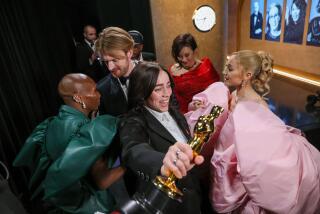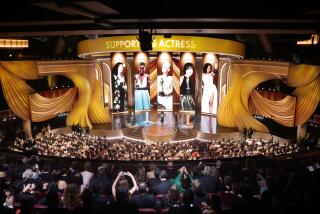The Oscars that are in the details
Special effects
To create a tentacle-faced Davy Jones and other cutting-edge computer-generated special effects in “Pirates of the Caribbean: Dead Man’s Chest,” John Knoll and other members of Industrial Light & Magic first had to create Imocap, a new motion-capture system.
Until Imocap, it took 16 cameras, specific lighting cues, a sound stage and a blue screen to digitally record movement in a motion-capture system. The setup was the opposite of portable.
But Imocap is sort of a “have motion-capture, will travel” arrangement. With just three cameras and a new form of sensor-embedded suit for the actors whose movements are being recorded, filmmakers can shoot on location without having to worry about blue screens, sound stages or lighting. Knoll shares the nomination with Hal Hickel, Charles Gibson and Allen Hall.
Telling detail: Knoll created his first motion-capture system 22 years ago as his senior thesis at USC’s School of Cinema and Television.
Makeup
“Apocalypto” director Mel Gibson gave Aldo Signoretti a lot of artistic license to design the makeup and hair of the film’s Maya characters.
Tattoos were an important part of the ancient culture; Signoretti used them, and body painting, liberally, often dyeing characters’ hair to match their body paint. He worked to emphasize the decadence of the upper classes. Signoretti shares the nomination with Vittorio Sodano.
Telling detail: It took a crew of 300 to apply tattoos, body painting, various types of makeup and elaborate wigs to the large cast.
Costume design
For “Dreamgirls,” Sharen Davis had to create 120 dresses from scratch to show the ever-changing styles of the fictional R&B; group the Dreamettes and come up with dozens of eye-poppingly glitzy suits for Jamie Foxx and Eddie Murphy.
For the film’s finale, she tapped one of her favorite couture designers -- Neeam Kahn -- to create slinky titanium chain mail gowns.
Telling detail: The metal gowns each weigh about 12 pounds. Estimated retail price: more than $10,000 a pop.
Animated feature film
Assembling Disney/Pixar’s animated film “Cars” was a labor- and research-intensive project for writer-director John Lasseter and a village of animators and computers.
Lasseter, whose father was a parts manager at a Chevy dealership in Whittier, traveled with his animation team to Detroit, talking to auto designers and visiting factories, old car restorers and race shops. Not only did Lasseter attend NASCAR races, he also took race car driver lessons.
Animators drew up some 43,000 sketches for the catchy automobiles seen in the film, the designs inspired by car sculptures on display in the business district of Detroit.
Telling detail: Though the computers -- Apples, natch -- ran four times faster than those used on the Oscar-winning 2004 Pixar/Disney film “The Incredibles,” it still took 17 hours to process a single frame of “Cars.”
Art direction
“Pan’s Labyrinth” production designer Eugenio Caballero was responsible for bringing to vivid life writer-director Guillermo del Toro’s gothic fairy tale universe as well as the brutal, unrelenting world of Franco’s fascist 1944 Spain. The film was shot on location in Segovia as well as the Sierra de Guadarrama mountain range outside of Madrid in summer 2005, and Caballero was challenged with re-creating lush green mountain settings in the relentlessly hot and dry Spanish countryside.
The healthy grass and moss-covered trees? They were crafted from green wood and thread.
Telling detail: Caballero and his crew built all 36 sets from scratch, including the decrepit stone-based labyrinth, the dark, forbidding lodge and the Pale Man’s Cocteau-esque lair.
-- Susan King



